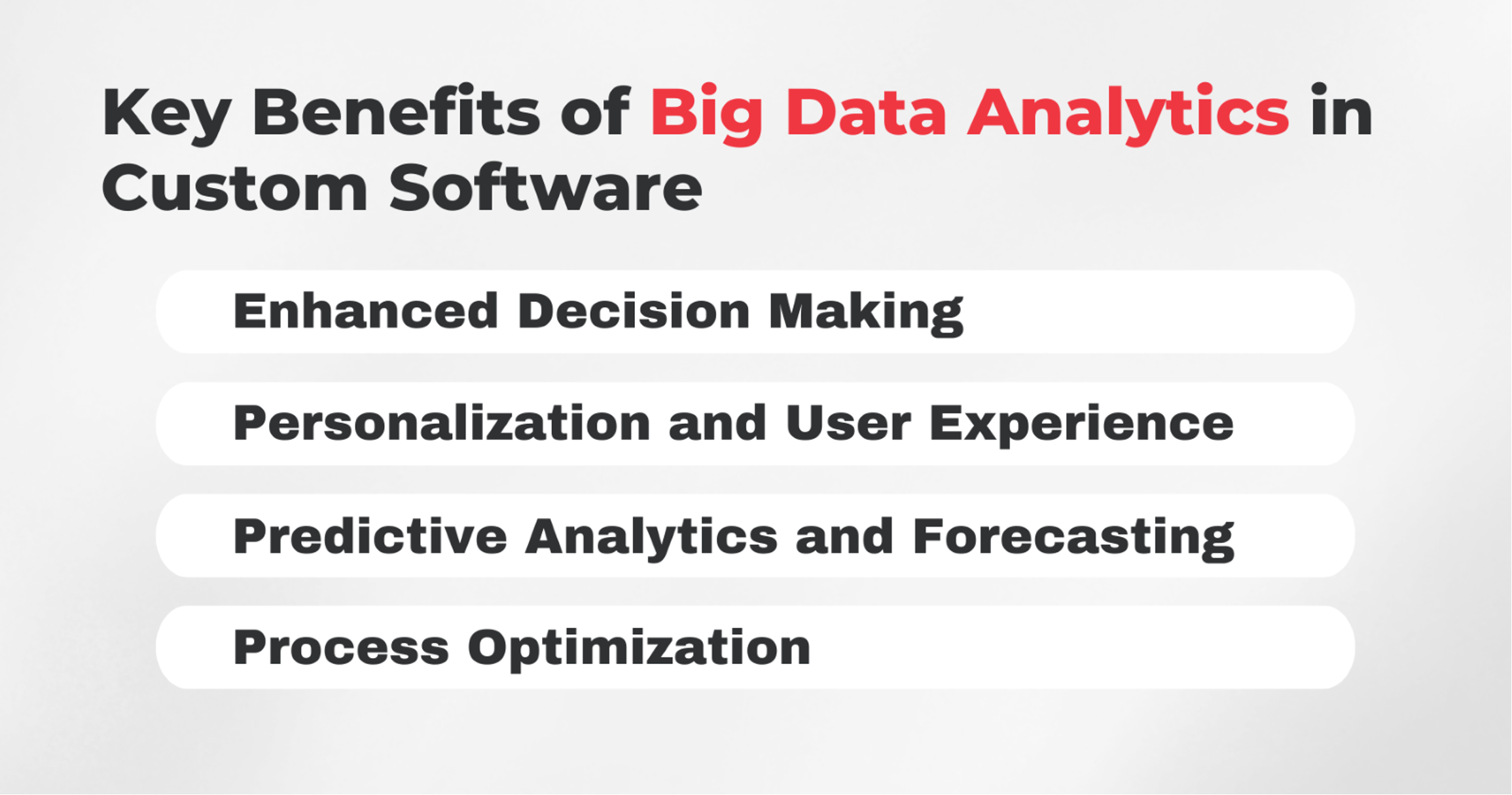In today's data-driven world, the convergence of big data analytics and custom software solutions is revolutionizing how businesses operate. Big data analytics involves examining large and complex data sets to uncover valuable insights, patterns, and trends. Custom software solutions, on the other hand, are tailored applications designed to meet an organization's specific needs and requirements. As the volume and variety of data continues to grow exponentially, integrating big data analytics into custom software has become a strategic imperative for companies seeking to stay competitive.

The Intersection of Big Data and Custom Software
Custom software solutions have the unique ability to harness the power of big data analytics to drive business value. By leveraging data-driven insights, custom applications can enable organizations to make smarter decisions, optimize processes, and deliver personalized user experiences. The synergy between big data and bespoke software lies in the ability to transform raw data into actionable intelligence that aligns with a company's specific goals and objectives.
For instance, a retail company can develop a custom inventory management system that integrates real-time sales data, customer preferences, and supply chain information. By analyzing this data, the software can predict demand fluctuations, optimize stock levels, and suggest targeted promotions. This level of data-driven optimization can significantly reduce costs, improve customer satisfaction, and boost overall profitability.
You may also like: Maximizing the Value of Cloud Analytics and Big Data
Here's a simplified example of how predictive analytics can be implemented in Python using the scikit-learn library:
```python
from sklearn.linear_model import LinearRegression
from sklearn.model_selection import train_test_split
# Prepare and split the data into training and testing sets
X_train, X_test, y_train, y_test = train_test_split(X, y, test_size=0.2)
# Train a linear regression model
model = LinearRegression()
model.fit(X_train, y_train)
# Make predictions on new data
predictions = model.predict(X_test)
```
https://youtu.be/KLr1pkBzY8?si=7nyWPvw-p-Ltesf
Key Benefits of Big Data Analytics in Custom Software
Incorporating big data analytics into custom software solutions offers a range of compelling benefits for organizations across industries.
Enhanced Decision Making
One of the primary advantages of leveraging big data in custom applications is the ability to make data-informed decisions. By analyzing diverse data sources, businesses can gain a comprehensive understanding of their customers, market trends, and operational performance. These insights enable leaders to make swift, confident decisions based on empirical evidence rather than gut instincts.
For example, a financial institution can develop a custom risk assessment platform that analyzes customer data, transactional history, and market conditions to identify potential credit risks. By combining internal and external data sources, the software can provide a holistic view of a customer's creditworthiness, enabling loan officers to make more informed decisions and mitigate potential losses.
Here's a sample code snippet illustrating how to calculate a simple credit score using Python:
```python
def calculatecreditscore(paymenthistory, creditutilization, lengthofcredit_history):
# Assign weights to each factor
payment_history_weight = 0.35
credit_utilization_weight = 0.30
length_of_credit_history_weight = 0.15
# Calculate the weighted scores
payment_history_score = payment_history * payment_history_weight
credit_utilization_score = credit_utilization * credit_utilization_weight
length_of_credit_history_score = length_of_credit_history * length_of_credit_history_weight
# Calculate the overall credit score
credit_score = payment_history_score + credit_utilization_score + length_of_credit_history_score
return credit_score
```
You may also like: How to Choose a Custom Software Development Partner
Personalization and User Experience
In the era of customer-centricity, delivering personalized experiences is a key differentiator. Big data analytics empowers custom software to tailor interactions, content, and recommendations to individual user preferences. By analyzing user behavior, demographics, and context, applications can adapt in real-time to provide highly relevant and engaging experiences. This level of personalization fosters customer loyalty, increases satisfaction, and drives business growth.
Take, for instance, a fitness-tracking application that collects data from wearable devices and user inputs. By analyzing this data, the app can provide personalized workout plans, nutrition recommendations, and progress insights tailored to each user's goals, fitness level, and lifestyle. This level of customization not only enhances the user experience but also improves the effectiveness of the fitness program.
Here's an example of how personalized recommendations can be generated using Python and the pandas library:
```python
import pandas as pd
# Load user data
user_data = pd.read_csv('user_data.csv')
# Define the target user
target_user_id = 123
# Find similar users based on specified attributes
similar_users = user_data[
(user_data['age'] == user_data.loc[target_user_id, 'age']) &
(user_data['gender'] == user_data.loc[target_user_id, 'gender']) &
(user_data['fitness_level'] == user_data.loc[target_user_id, 'fitness_level'])
]
# Generate personalized recommendations based on similar users' preferences
recommended_workouts = similar_users['preferred_workout'].mode().tolist()
recommended_nutrition_plan = similar_users['nutrition_plan'].mode().tolist()
```
Predictive Analytics and Forecasting
Custom software solutions powered by big data can unlock the potential of predictive analytics and forecasting. By identifying patterns and correlations in historical data, these applications can generate accurate predictions about future trends, customer behavior, and market dynamics. Industries such as retail, healthcare, and finance are leveraging predictive analytics to optimize inventory management, improve patient outcomes, and detect fraudulent activities.
For example, a healthcare provider can develop a custom patient monitoring system that analyzes electronic health records, sensor data from medical devices, and patient feedback. By applying predictive analytics to this data, the software can identify patients at high risk of complications, suggest preventive interventions, and optimize treatment plans. This proactive approach can significantly improve patient outcomes, reduce healthcare costs, and enhance the overall quality of care.
Here's a sample code snippet demonstrating how to build a simple predictive model using Python and the scikit-learn library:
```python
from sklearn.ensemble import RandomForestClassifier
from sklearn.modelselection import traintest_split
Prepare the data
X = ... # Independent variables (e.g., patient data)
y = ... # Dependent variable (e.g., patient outcome)
Split the data into training and testing sets
Xtrain, Xtest, ytrain, ytest = traintestsplit(X, y, test_size=0.2)
Create and train the model
model = RandomForestClassifier()
model.fit(Xtrain, ytrain)
Make predictions
predictions = model.predict(X_test)
```
Process Optimization
Big data analytics can help organizations streamline and optimize their business processes. By analyzing data from various touchpoints, custom software can identify inefficiencies, bottlenecks, and areas for improvement. For example, a manufacturing company can use sensor data from equipment to predict maintenance needs and minimize downtime. Similarly, a logistics firm can optimize routes and reduce fuel consumption by analyzing traffic patterns and weather data.
Let's consider a custom supply chain management system for a global e-commerce company. By integrating data from suppliers, warehouses, transportation providers, and customer orders, the software can optimize inventory levels, streamline order fulfillment, and predict potential delays. This data-driven approach can reduce costs, improve delivery times, and enhance customer satisfaction.
Here's an example of how to optimize inventory levels using Python and the scipy library:
```python
from scipy.optimize import minimize
def objective_function(inventory_levels, demand_forecast, holding_cost, shortage_cost):
total_cost = 0
for inventory, demand in zip(inventory_levels, demand_forecast):
if inventory < demand:
total_cost += (demand - inventory) * shortage_cost
else:
total_cost += (inventory - demand) * holding_cost
return total_cost
# Demand forecast and cost parameters
demand_forecast = [100, 150, 120, 200]
holding_cost = 0.5
shortage_cost = 1.0
# Initial guess for inventory levels
initial_inventory = [100, 100, 100, 100]
# Optimize inventory levels
optimized_inventory = minimize(objective_function, initial_inventory, args=(demand_forecast, holding_cost, shortage_cost))
print("Optimized Inventory Levels:", optimized_inventory.x)
```
Challenges in Implementing Big Data Analytics in Custom Software
While the benefits of integrating big data analytics into custom software are substantial, organizations must navigate several challenges to ensure successful implementation.
Data Quality and Management
One of the primary hurdles is ensuring the quality and integrity of data. Inaccurate, incomplete, or inconsistent data can lead to flawed insights and decision-making. Organizations must establish robust data governance frameworks, including data cleansing, validation, and standardization processes. Additionally, managing the sheer volume and variety of big data requires scalable storage solutions and efficient data integration techniques.
For instance, a marketing agency developing a custom customer analytics platform must ensure that customer data from various sources, such as social media, website interactions, and CRM systems, is accurately merged and deduplicated. Failing to do so can result in incorrect customer profiles and ineffective marketing strategies.
Here's a sample code snippet illustrating basic data cleansing using Python and the pandas library:
```python
import pandas as pd
# Load the data
data = pd.read_csv('customer_data.csv')
# Remove duplicate entries
data = data.drop_duplicates()
# Handle missing values
data = data.fillna(0) # Fill missing values with 0
# Standardize column names
data.columns = [col.lower().replace(' ', '_') for col in data.columns]
# Save the cleaned data
data.to_csv('cleaned_customer_data.csv', index=False)
```
Scalability and Performance
Dealing with the scale and complexity of big data presents significant technical challenges. Custom software must be designed to handle massive volumes of structured and unstructured data, often in real-time. This requires a scalable and resilient infrastructure that can accommodate growing data demands without compromising performance. Techniques such as distributed computing, parallel processing, and in-memory analytics can help address scalability issues and ensure optimal performance.
For example, a social media analytics platform must be able to process billions of tweets, posts, and interactions in near real-time. The architecture must be designed to scale horizontally, distributing the workload across multiple nodes and ensuring high availability. Failure to address scalability can result in slow performance, system crashes, and lost opportunities.
Here's a sample code snippet demonstrating parallel processing using Python and the multiprocessing library:
Final Thoughts
The integration of big data analytics into custom software solutions is a game-changer for organizations seeking to harness the power of data-driven insights. By leveraging the synergy between tailored applications and big data, businesses can make better decisions, optimize processes, and deliver personalized experiences to their customers. However, implementing big data analytics in custom software comes with challenges, including data quality, privacy, and scalability issues.
By following best practices such as defining clear objectives, selecting the right tools, ensuring data accessibility, and embracing continuous improvement, organizations can successfully navigate these hurdles. As technology advances, trends like artificial intelligence, machine learning, edge computing, and the Internet of Things will further shape the future of big data analytics in custom software.
In the end, the successful convergence of big data analytics and custom software requires a strategic approach that aligns technology with business goals. By investing in the right talent, infrastructure, and processes, organizations can unlock the transformative potential of data-driven insights and stay ahead in an increasingly competitive landscape.
Ready to harness the power of data-driven insights? Contact us to explore how custom software solutions powered by big data analytics can transform your business and drive success!
Frequently Asked Questions
1. What is the role of data analytics in software development?
Data analytics plays a critical role in software development by providing developers with actionable insights based on real-world data. These insights help optimize software performance, enhance user experience, and align software functionality with business objectives, ultimately driving better outcomes.
2. What is the role of big data in software development?
Big data empowers software developers to analyze and process vast datasets, uncovering trends and patterns that can improve software design and efficiency. It also helps developers predict user behavior, ensure scalability, and create more robust and innovative applications.
3. What is the purpose of big data analytics?
The purpose of big data analytics is to process and analyze large, complex datasets to uncover meaningful insights and patterns. This helps organizations make informed decisions, improve operational efficiency, and identify new opportunities for growth and innovation.
4. What is the role of big data in business intelligence?
Big data is vital to business intelligence as it provides real-time, comprehensive insights into organizational performance and market trends. By leveraging these insights, businesses can make data-driven strategic decisions, identify risks, and stay competitive in a rapidly changing environment.





